Most people associate clogs with Holland and don’t realise that English clog dancing was incredibly popular in the 19th century. English clogs with wooden soles and leather uppers were comfortable and cheap – ideal for workers in the mills, factories and mines which sprang up in the industrial revolution. Clog dancing developed initially to lighten the boredom of such jobs but soon emerged as a distinctive dance form.
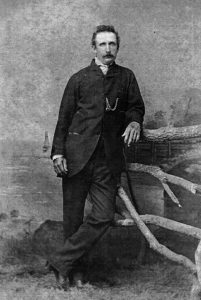
Harry Macklin Shaw, champion clog dancer of Australasia and great-great-grandfather of Craig Revel Horwood. (Image: BBC)
This is the story of Harry Macklin Shaw, a boy from Lancashire who became the Australasian Champion of English Clog Dancing in the 1870s. Harry was born in 1840 and spent his early years in Ashton-under-Lyne, near Manchester in the heart of the cotton-milling centres of northwest of England. At the age of eleven he was working as a cotton piecer. Two of his brothers and a sister also worked in a cotton mill. It was customary for children as young as four to start learning the dance steps, which they would continue to use with pleasure throughout their lives. Harry’s parents came from Ireland, in common with many others who sought employment in the burgeoning cotton industry. They undoubtedly encouraged his talent and perhaps added an infusion of Irish steps to his repertoire.
In 1863, Harry was sponsored to emigrate to New South Wales, where he joined his older brother to start a new life in Australia. He gained employment on at the Clearveaux sheep station near Glen Innes, NSW. There are many accounts of rural workers – shearers, bullockies, farmers, and even bushrangers – who were accomplished step dancers. Competitions were often held in pubs to prove who was the most expert dancer. Harry had almost certainly brought a degree of expertise as a dancer with him and would have been able to enhance this further in the active clog dance scene in Australia.
In 1871, he issued this challenge:
I, HARRY MACKLIN, am open to dance any man in Australia at Hornpipe Dancing, for £20-which dances the most steps, dances them the cleanest, and keeps the best time, or any given quantity of steps. Man and money ready at J. Meek’s, Westmoreland street, Forest Lodge.
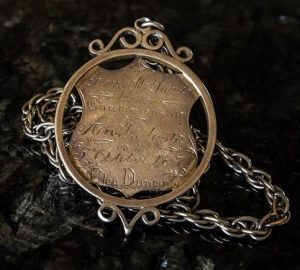
Harry Macklin Shaw’s medal proclaiming him Clog Dancing Champion of Australasia. Photo courtesy of Peter Shaw.
Harry must have been supremely confident in his ability, as £20 was a considerable sum to wager. As he won the Australasian Clog Dancing Championship in 1871, presumably his confidence was well placed. The fine medal he was awarded has been treasured by his family ever since. Despite clog dancing and competitions being extremely popular in Australia in colonial times, this is the only known medal from such an event.
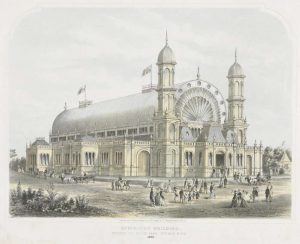
The Exhibition Building where Harry performed in 1872. National Library of Australia. http://nla.gov.au/nla.obj-135294185
There is no further information about the challenge, but the following year, Harry is acclaimed as “the champion clog dancer…in his celebrated dances” at the Grand Gala Day of 26 January in the newly completed Exhibition Building in Sydney. This event would have attracted thousands of spectators – a similar event in Melbourne in 1869 drew an audience of 18,000.
Harry later became a miner in Emmaville near Glen Innes and was an active participant in the social life of the community. He organised local social dances, where he acted as the Master of Ceremonies and provided his talents as a performer at various events including a benefit night to raise funds for the Glen Innes Hospital.
Although we have no record of the specific steps he danced, articles describe his “celebrated” and “really excellent step-dancing”, while one account classifies his dance as “graceful and inimitable”. He undoubtedly performed a variety of dances, though only the hornpipe is mentioned specifically; it is likely his repertoire included clog dances set to waltz and schottische tunes, jig and reels, which were popular at the time. For dramatic effect, the dances could be performed on a raised pedestal and Harry himself used this device. A pedestal usually measured 15 inches square (about 38 cm) and was raised a metre or more. This emphasised the percussive sound of the steps and displayed the virtuosity of the performance.
Sadly, Harry was involved in a mining accident in 1883 and died in 1884 after being paralysed for four months.
In 2017 we celebrated Harry’s clog dancing career in an episode of Who Do You Think You Are? which traced Craig Revel Horwood’s family history. Craig is an extremely well known television personality in the United Kingdom, a professional dancer, choreographer and theatre director, who has for many years been a judge on the BBC production Strictly Come Dancing.
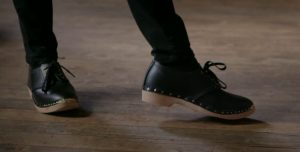
“I wanted to follow my heart, my passion, my dreams of dancing, and it’s just amazing to know that that actually runs in the family and in the blood. So it really has put a new twist on who I think I am”.
The episode of Who Do You Think You Are? went to air on July 13 2017, and revealed that Harry Shaw was his great-great grandfather.
Craig thought that it was wonderful to discover the connection and to feel that dancing and performance was in his blood, running down the generations. It was a delight to be involved in the search for more information about Harry and share this with Craig on the programme. It was also a very special opportunity to present an unique aspect of Australian dance history to a wide audience.
We were fortunate to have available a step dance tune that would very likely have been around when Harry was in Emmaville. The tune, known as ‘The Breakdown’ was collected by the folklorist Dave de Hugard from the New England button accordion player, Kath McCaughey (1901 – 1989). Kath had learnt the tune from her parents who were both fiddlers and who had played together for local dances in the New England area and Glen Innes in the latter part of the 19th century. This is the tune used for the clog dance performed in Who Do You Think You Are?. (Listen to the tune or download the sheet music)
Craig was inspired to create a show with the Ballet Boyz about the Eureka Stockade. View the short preview here, and the live rehearsal here.
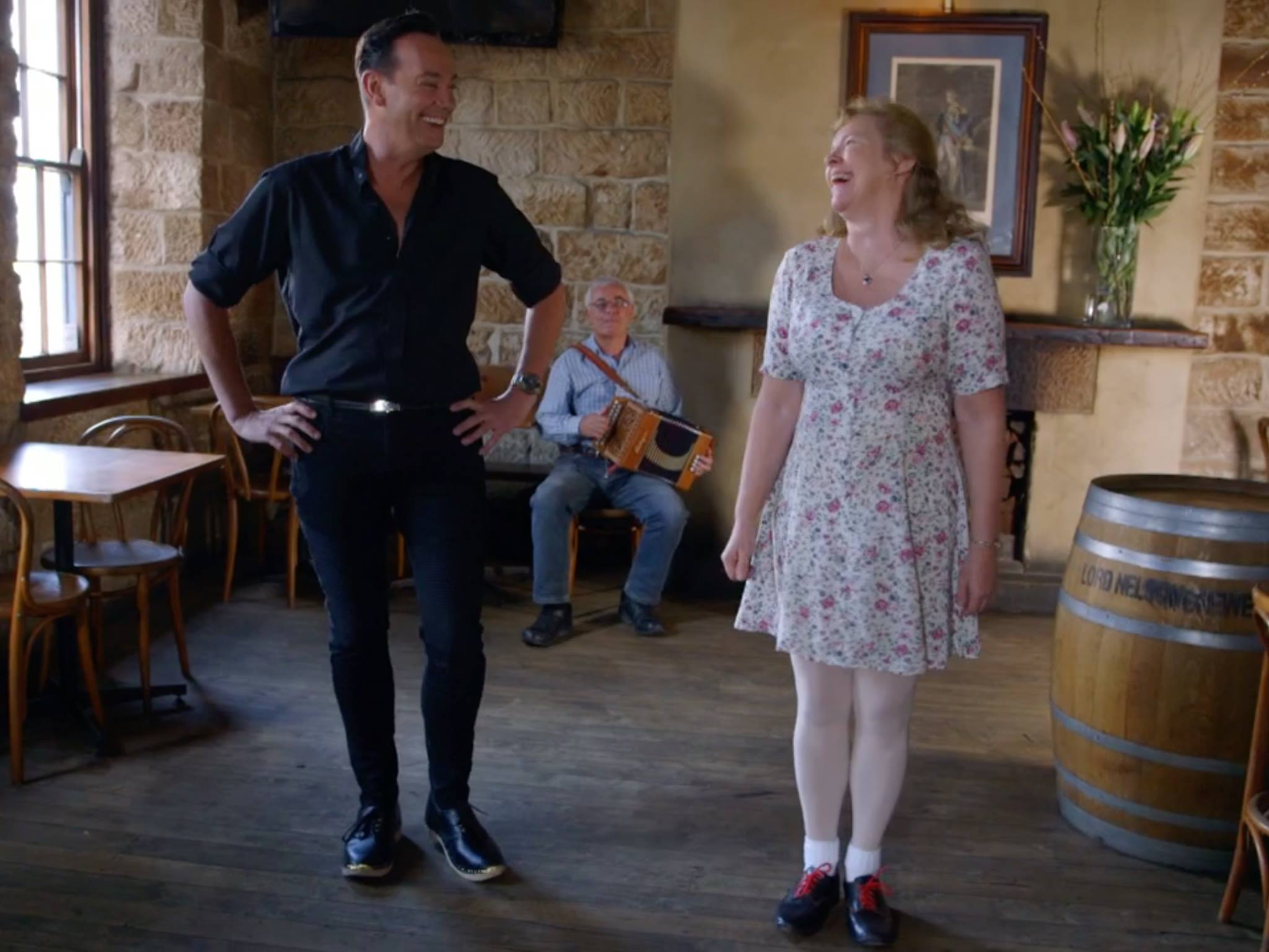
Craig Revel Horwood and dance historian Heather Clarke filming Who Do You Think You Are? at the Lord Nelson, The Rocks, Sydney. Music was supplied by Ian Hayden and Roland Clarke.
References and links.
Harry’s challenge
Advertising (1871, November 18). The Sydney Morning Herald (NSW : 1842 – 1954), p. 2. Retrieved February 8, 2017, from http://nla.gov.au/nla.news-article28417360
Harry Macklin at Grand Gala Day 1872
Advertising (1872, January 26). The Sydney Morning Herald (NSW : 1842 – 1954), p. 6. Retrieved March 5, 2017, from http://nla.gov.au/nla.news-article28417360
Pedestal dance at benefit for Glen Innes Hospital 1874
Advertising (1874, November 11). Glen Innes Examiner and General Advertiser (NSW : 1874 – 1908), p. 3. Retrieved February 17, 2017, from http://nla.gov.au/nla.news-article217833997
Ex-champion at The Royal Assembly Rooms, Glen Innes 1877
Advertising (1877, August 15). Glen Innes Examiner and General Advertiser (NSW : 1874 – 1908), p. 4. Retrieved February 17, 2017, from http://nla.gov.au/nla.news-article217809435
Philanthropic Dramatic Club, Glen Innes 1877
Local and Other notes. (1877, August 22). Glen Innes Examiner and General Advertiser (NSW : 1874 – 1908), p. 2. Retrieved February 8, 2017, from http://nla.gov.au/nla.news-article217809982
MC at the Oddfellows’ Ball 1880
ODDFELLOWS’ BALL. (1880, November 23). Glen Innes Examiner and General Advertiser (NSW : 1874 – 1908), p. 2. Retrieved February 8, 2017, from http://nla.gov.au/nla.news-article217783256
1881 Dancing at Good Templar’s Picnic
Dancing under the trees and a step dancing performance Harry. Ball and another performance in the evening.
GOOD TEMPLARY AT VEGETABLE CREEK. (1881, January 11). Glen Innes Examiner and General Advertiser (NSW : 1874 – 1908), p. 2. Retrieved March 5, 2017, from http://nla.gov.au/nla.news-article217832785
Image of Exhibition Building. National Library of Australia
Leigh, S. T & S.T. Leigh & Co. (1870). Exhibition building erected in Alfred Park, Sydney, N.S.W Retrieved July 20, 2017, from http://nla.gov.au/nla.obj-135294185
Photo of Harry Macklin Shaw and summary of episode
https://www.whodoyouthinkyouaremagazine.com/episode/craig-revel-horwood/
Who Do You Think You Are? BBC iPlayer
http://www.bbc.co.uk/programmes/b08y6ct1
SBS
This episode screened on SBS Australia in late 2017.



4 Responses to Harry Shaw – champion clog dancer